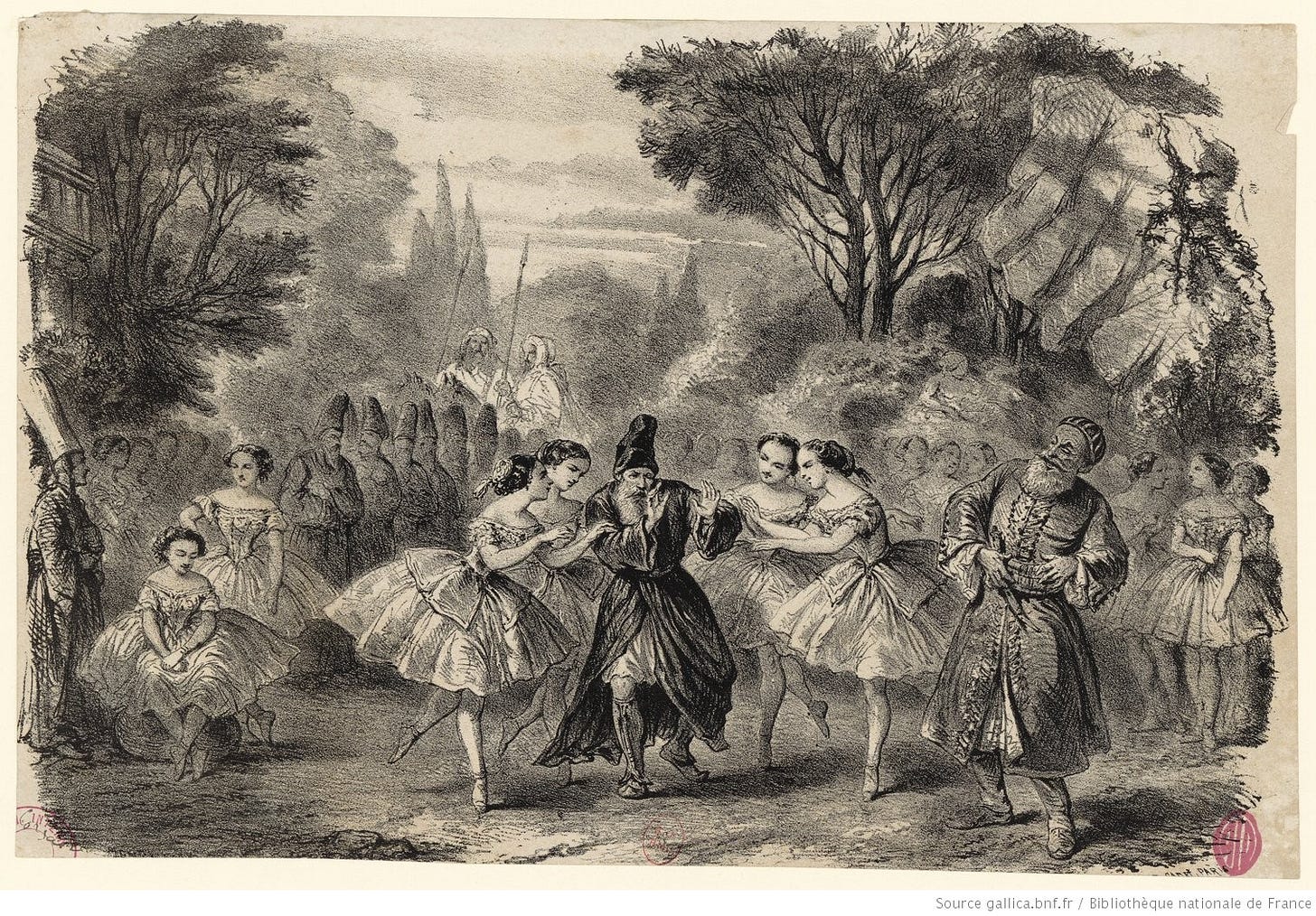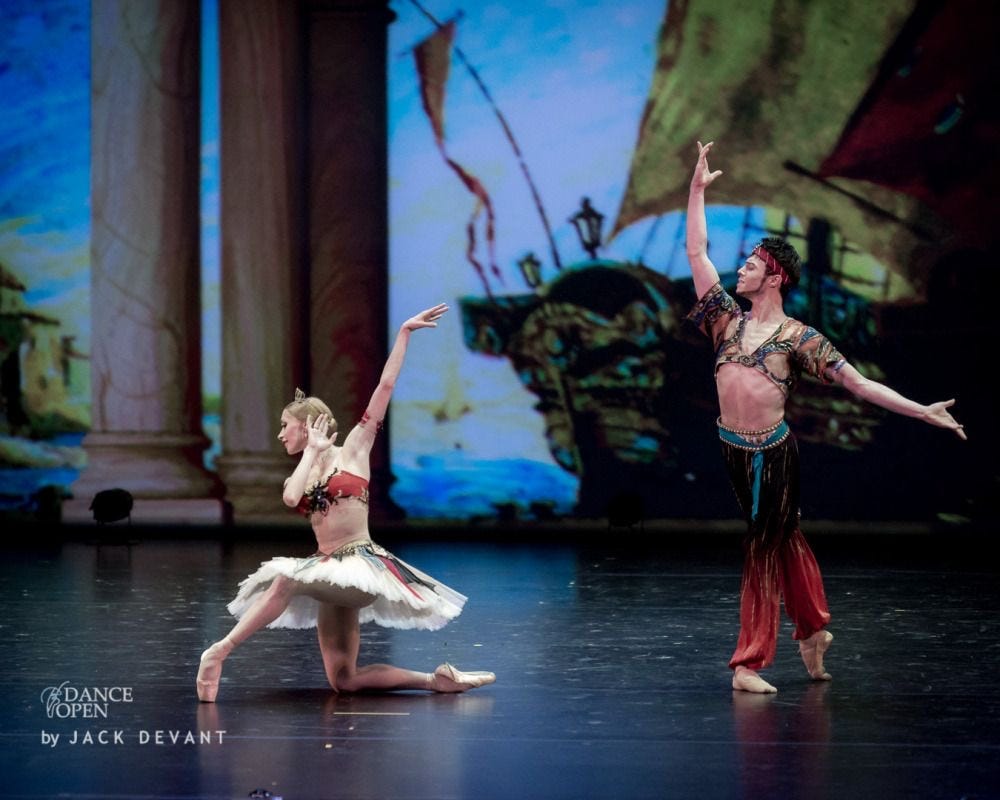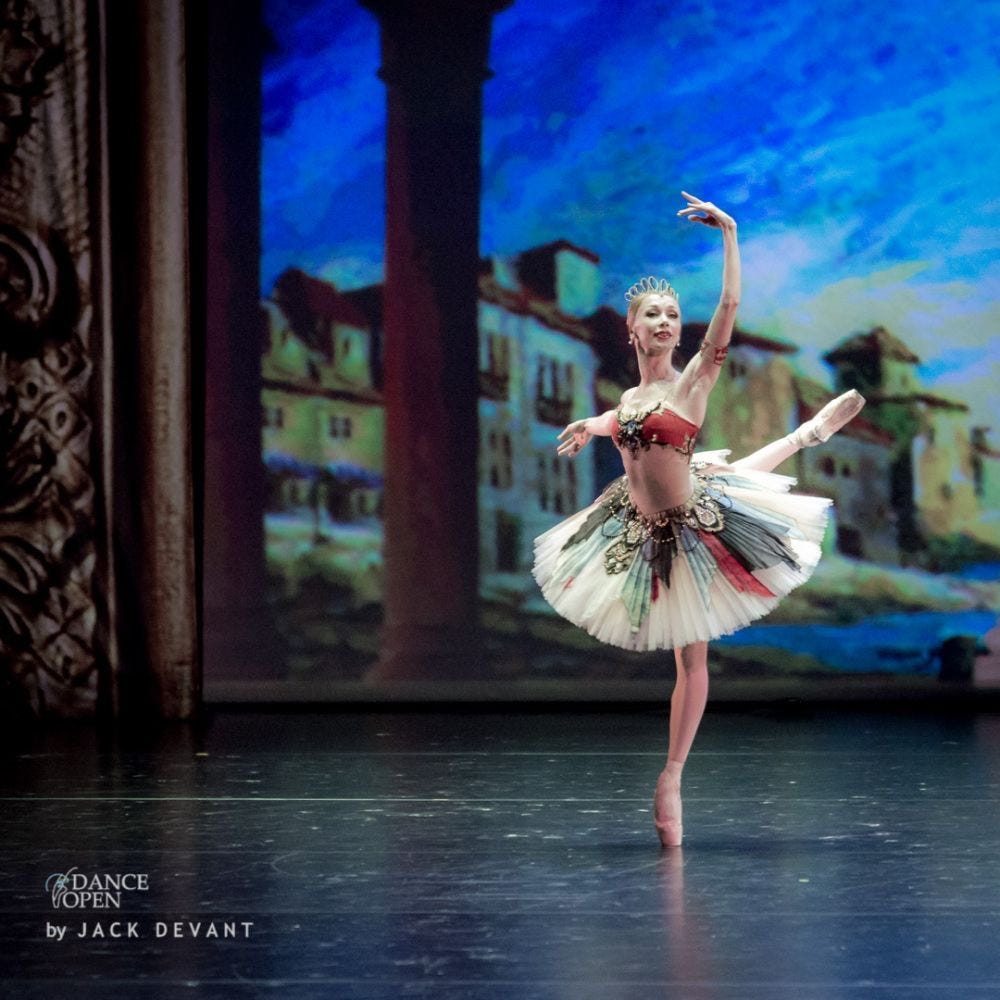Le Corsaire is one of the few ballets created in post-Romantic Paris that still dominates the repertoire today. Created by Joseph Mazilier and Adolphe Adam, staged in three acts and five scenes and loosely based on the poem by Lord Byron, it tells the story of the pirate Conrad and his mission to save his beloved Medora from an unwanted marriage to the Seyd Pasha. The ballet premièred at the Salle Le Peletier in Paris on the 23rd January 1856. Two years later, Le Corsaire was introduced to Russia by Jules Perrot, who staged it for the Saint Petersburg Imperial Ballet in 1858. It was in Russia that the ballet was given a permanent home, mainly thanks to the revivals of Marius Petipa, who staged four revivals in 1863, 1868, 1880 and 1899 respectively.

As with all the Parisian ballets that survived in Russia, survival meant Le Corsaire would have undergo some changes, namely the introductions of new music and dances. Adam’s music score would undergo multiple revisions to include new numbers and materials by Cesare Pugni, Petr Georgievich, Duke of Oldenburg, Léo Delibes and Riccardo Drigo, nearly all of which went onto become the ballet’s most famous numbers. One such number is the Pas d’esclave, a pas de deux that is performed in Act 1, scene 1, as well as in galas and competitions. Contrary to popular belief, the Pas d’esclave is not an original number by Adam and Mazilier, but a new piece that was introduced by Perrot and Pugni in 1858. In this article, I will explore the history of this famous pas, starting with the scenario of the opening scene in the original Paris production.
The original Paris production, 1856
Act 1, scene 1 is a set in a marketplace in Adrianople where slave traders are looking to sell their female slaves. Conrad and his band of corsairs arrive, and he explains he has come to meet his beloved Medora, who appears on her balcony and throws him a selam of flowers as a token of her love. However, Medora’s guardian, Isaac Lanquedem orders her inside. The Seyd Pasha arrives, and the slave traders try to sell him some of their women, but none interest him until he catches sight of Medora and insists on buying her. Lanquedem agrees to the sale, much to Medora’s dismay, but Conrad hatches a plan to “kidnap” her, to which she complies. Conrad calls the corsairs to drink and make merry and when he gives the signal, the corsairs make off with Medora, Lanquedem and the slave girls to their ship and they set sail to their hideout.
Adam’s original score for the 1856 production included two dances in the first scene. The first was a pas de cinq, performed by five female slaves of different nationalities – Italian, Polish, French, Spanish and English. The pas is composed of an entrée, five variations and a coda. It is a character-variety dance suite with the dancers wearing heeled shoes and native costumes, combining academic and character-style vocabulary. The context of the pas de cinq is that each of the women are trying to impress the Pasha, but he shows no interest in any of them as he wants to buy Medora only.
The second dance was the Corsairs’ bacchanale, an exciting, energetic dance originally performed by Conrad’s first mate Birbanto and two female soloists, and a corps de ballet of sixteen men and women. The latter dance is the scene’s finale as the corsairs stir up merriment before Conrad gives the signal for them to “abduct” Medora and the other women.
The Saint Petersburg production, 1858
When Le Corsaire was brought to Russia by Perrot in 1858, while the original plot was retained, changes awaited the libretto in the form of new dances. For the first scene, only the Corsairs’ bacchanale was retained, but in a revised version by Pugni, who expanded it with new music. The Pas de cinq was omitted and at the première, a new dance entitled the pas Aragonnaise was performed by the Polish dancer Wiktoria Koslovska, (a guest artist from the Warsaw Opera), two female students and three men. The music might have been by Pugni, though this is unclear. What is clear is that this number seems to only have been added especially for Koslovska because by the 16th April [O.S. 4th April] 1858, it was no longer listed on the poster. Possibly around the same time, if not later, a new dance was introduced to the first scene – L’esclave, pas scènique, which eventually came to be known as the Pas d’esclave.
It has been widely believed that Petipa, who played Conrad in the 1858 production, served as Perrot’s assistant and was given permission to choreograph new dances, which were believed to have been the Pas d’esclave and the Pas de trois des odalisques from Act 2. However, this has been reported without concrete evidence, which, according to Doug Fullington and Marian Smith, could be part of a trend among scholars of giving more credit to Petipa than to other choreographers of the 19th century whose works and contributions are not as well-known as the former’s.[1] In other words, this could be a case of turning too quickly to the figure with the highest profile and ignoring the others. The idea of Petipa serving as assistant to Perrot, however, is admittedly perfectly plausible as he had previously co-staged Parisian ballets in Saint Petersburg after his arrival in 1847. In the case of who introduced the new dances to Le Corsaire, including L’esclave, pas scènique, the evidence points to Perrot. Ivor Guest, Perrot’s biographer, noted that Perrot had added a new dance to the first scene for Marfa Muravieva, the Imperial Theatre’s rising star at the time. A poster for a performance on the 20th November [O.S. 8th November] 1859 credits the choreography of L’esclave, pas scènique to Perrot and the music arrangement to Pugni.
The pas was originally composed of an entrée, adagio and coda and the music is by Petr Georgievich, Duke of Oldenburg, arranged by Pugni. Grand Duke Petr Georgievich was the cousin of the Tsar, grandson of Tsar Paul I and an amateur composer. The music in question inserted into Le Corsaire is from his ballet The Rose, the Violet and the Butterfly, which premièred in 1857.[2] L’esclave, pas scenique was originally performed by three dancers – a male-female couple (the female dancer was Muravieva) and Isaac Lanquedem (Alexander Picheau?)[3] and the context of the pas is a slave trader trying to sell his slave, similar to that of the pas de cinq. Interestingly, the poster for the aforementioned 1859 performance lists Muravieva, Alexander Prosbin and Nikolai Golts (the Pasha) as the performers, though it is not clear if major changes or any changes were made.
Petipa’s revivals
The first of Petipa’s revivals of Le Corsaire premièred on the 5th February [O.S. 24th January] 1863. Collaborating with Pugni, Petipa began making his own touches to the ballet, including further revisions on those introduced by Perrot, the introduction of new dances of his own design and expanding the ballet from three acts and five scenes into four acts and five scenes. But what of L’esclave, pas scènique? The poster does not name Lanquedem or the Pasha as one of its performers, so it seems that this was when the pas was first performed as a pas de deux. In Petipa’s second revival, which premièred in 1868, the pas was now simply called L’Esclave and had seemingly been expanded into a pas de six, as suggested by the number of dancers who performed it. The poster lists Alexandra Shaposhnikova and Lev Ivanov, accompanied by four women. For the benefit performance of Ekaterina Vazem that was held on the 16th February [O.S. 4th February] 1873[4], Petipa added a new Pas d’esclave in the opening scene that was performed by Vazem (Medora), Ivanov (Conrad), Picheau (Lanquedem) and Pavel Gerdt as an additional cavalier. It appears that this Pas d’esclave was a new piece completely different from L’Esclave, which was not listed on the poster, as stated by the following account of the critic of Petersburgskaya Gazeta:
She [Vazem] showed all the strength of her talent in the exemplary performance of a new large pas d’ésclave specially staged for her by M. Marius Petipa[5].
However, there appears to be no mention of what music was used for this new pas. If it was not Duke Oldenburg’s music, perhaps it was an arrangement of other music by Pugni or Adam or it was new music, maybe composed by Ludwig Minkus[6], but, of course, this is just conjecture.
L’Esclave was included in the 1899 revival (Petipa’s final revival) and by then, it was now known by the familiar title Pas d’esclave and was performed by a male slave trader and a female slave. The Pas d’esclave is among the dances included in the notation scores of the Sergeyev Collection, notated by the Imperial Theatre regisseur Nikolai Sergeyev and his assistants. Le Corsaire was notated between 1894 and 1906, and the Pas d’esclave is dated 1905. The scores reveal that by this point, the structure of the pas was the entrée, adagio, two variations and the coda. The names of the dancers on the scores are those of Varvara Rykhlyakova and Sergei Legat. Rykhlyakova performed the Pas d’esclave in the 1899 première with Nikolai Legat (Sergei’s brother) and Sergei Legat performed it with Lydia Kyaksht on the 2nd October [O.S. 19th September] 1904, the first performance of Le Corsaire in the 1904-05 season.
One thing that is not quite clear, however, is when variations were introduced to the Pas d’esclave. Both variations included in the repetiteur score in the Sergeyev Collection were composed after 1880 (the year of Petipa’s third revival), though variations might have been included after Petipa’s first revival in 1863, but they would not have been the variations that are danced today. The two variations in the Sergeyev Collection are those that are danced today. According to the piano edition of the Le Corsaire score owned by Yuri Burlaka, the male variation was composed by Vladimir Tsybin, an artist of the Mariinsky Orchestra, and added to the Pas d’esclave in 1914. This variation was created especially for Pierre Vladimirov, who performed the pas on the 3rd January 1915 [O.S. 21st December 1914] with Lyubov Egorova and the poster credits Tsybin as the variation’s composer. However, the male variation is not notated, and it is unknown what variation(s) the Legat brothers danced. One might ask if they danced variation(s) at all, but the likelihood that they did is very high since they were two of the most frequent performers of male variations.
The repetiteur tells us that the female variation (which is notated) is from Petipa’s ballet The Vestal, which was composed by Mikhail Ivanov and premièred on the 17th February [O.S. 29th January] 1888. The variation is listed as the Variation of Maria Gorshenkova, who danced the second ballerina role of Claudia in the première. According to Burlaka, this variation is by Riccardo Drigo, who was the conductor at the première and is known to have composed several supplementary pieces that were interpolated into the score.
The notations also reveal that there is pantomime in the Pas d’esclave, which means it is a pas d’action rather than a pas de deux. The narrative tells us that the slave trader is trying to sell his slave to the Pasha, while the slave pleads with him not to buy her. Doug Fullington and Marian Smith provide the following account of what the notation scores tells us about the final section of the coda:
‘At the end of the coda, the woman runs to the Pasha and kneels in front of him, beseeching, “You, let me go,” to which he answers, “Go!” She runs away to centre and, after an initial pas de bourrée, performs a series of six demi-emboîtes derrière and “3 jété” three times to alternate sides. She approaches the Pasha a final time, performing temps levés en demi-arabesque, pas de bourrée six times to alternate sides. The Pasha bids her “Farewell, farewell,” suggesting he has ultimately acquiesced and let her go.’[7]
Today, Le Corsaire is staged in various productions and the Pas d’esclave remains one of its highlights. In many modern productions, it is performed by the second ballerina role Gulnare and Lanquedem, a tradition that seems to have started in Pyotr Gusev’s 1955 production for the Maly/Mikhailovsky Ballet, which became one of the most popular productions in Soviet Russia and is still performed today by the Mariinsky Ballet. Gusev’s production transferred Gulnare’s entrance to Act 1, as opposed to the original Paris production and subsequent Russian productions where she makes her first appearance in Act 2, while Lanquedem, like with many roles that were originally non-dance roles, became a second danseur role. The modern context of the Pas d’esclave became that Lanquedem persuades the Pasha to buy Gulnare, one of his most prized slaves, and the Pasha agrees.
One of several pieces of Le Corsaire with an interesting history, beginning as an interpolation that replaced an original number, the Pas d’esclave, under the creative eyes of Perrot, Pugni and Petipa became one of the ballet repertoire’s most famous and celebrated pieces and it continues to excite audiences whenever it is brought to the stage.
References
[1] Five Ballets from Paris and Saint Petersburg (2024) by Doug Fullington and Marian Smith, p. 409
[2] There is some confusion regarding the date and the location of the première and the identity of the choreographer of this ballet. Some credit Petipa, others credit Perrot; some sources say the première took place in October 1857 at the Imperial estate of Tsarskoe Selo; others say it was at the Imperial Bolshoi Theatre in Saint Petersburg.
[3] Picheau portrayed Lanquedem in the 1858 première.
[4] Vazem débuted as Medora opposite Petipa as Conrad on the 19th April [O.S. 7th April] 1868 and she performed in Le Corsaire for her benefit in 1873.
[5] Petersburgskaya Gazeta, 18th February [O.S. 6th February] 1873, qtd. in Khronika III, 145, qtd. in Five Ballets from Paris and St Petersburg (2024) by Doug Fullington and Marian Smith
[6] Minkus was the official Ballet Composer of the Imperial Theatres at the time, having succeeded Pugni, who had died three years earlier.
[7] From Five Ballets from Paris and St Petersburg (2024) by Doug Fullington and Marian Smith, p. 424
Sources
Doug Fullington and Marian Smith (2024) From Five Ballets from Paris and St. Petersburg. New York City, USA: Oxford University Press
Ivor Guest (1984) Jules Perrot, Master of the Romantic Ballet. London, UK: Dance Books Ltd
Nadine Meisner (2019) Marius Petipa: The Emperor’s Ballet Master. New York City, US: Oxford University Press









